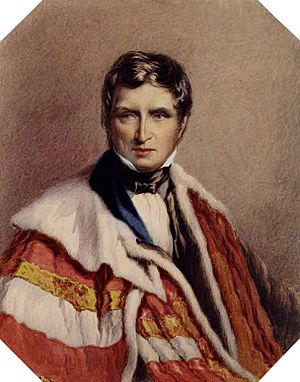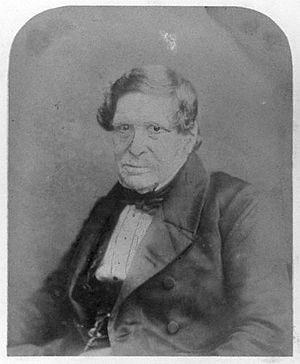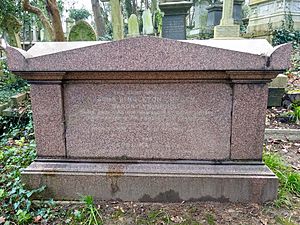John Copley, 1st Baron Lyndhurst facts for kids
Quick facts for kids
The Lord Lyndhurst
|
|
|---|---|

Lord Lyndhurst wearing the parliamentary robes of a baron, portrait by Felix Rogge c.1836
|
|
| Lord High Chancellor of Great Britain | |
| In office 2 May 1827 – 24 November 1830 |
|
| Monarch | |
| Prime Minister | |
| Preceded by | The Earl of Eldon |
| Succeeded by | The Lord Brougham and Vaux |
| In office 21 November 1834 – 8 April 1835 |
|
| Monarch | William IV |
| Prime Minister | |
| Preceded by | The Lord Brougham and Vaux |
| Succeeded by | In Commission |
| In office 3 September 1841 – 27 June 1846 |
|
| Monarch | Victoria |
| Prime Minister | Sir Robert Peel, Bt |
| Preceded by | The Lord Cottenham |
| Succeeded by | The Lord Cottenham |
| Personal details | |
| Born | 21 May 1772 Boston, Massachusetts British America |
| Died | 12 October 1863 (aged 91) London, United Kingdom |
| Nationality | British |
| Political party | Tory |
| Spouses |
Sarah Brunsden
(m. 1809; died 1834)Georgina Goldsmith
(m. 1837) |
| Alma mater | Trinity College, Cambridge |
John Singleton Copley, 1st Baron Lyndhurst (born May 21, 1772 – died October 12, 1863) was an important British lawyer and politician. He held the very high position of Lord High Chancellor of Great Britain three different times. This role is like being the chief judge and a key government minister.
Contents
Early Life and Education
John Singleton Copley was born in Boston, Massachusetts. At that time, Boston was part of British America. His father, also named John Singleton Copley, was a famous painter. His mother was Susanna Farnham (née Clarke).
In 1774, his father moved to London, England. John and his mother joined him a year later. John went to a private school. Later, he studied at Trinity College, Cambridge, a well-known university. He was a very good student, graduating as a "second wrangler". This means he was the second-highest scoring student in mathematics in his year.
Becoming a Lawyer and Politician
Starting His Legal Career
In 1804, John Copley became a lawyer at Lincoln's Inn in London. He quickly became very successful. He was appointed a "serjeant-at-law" in 1813. This was a special type of senior lawyer.
In 1817, he worked as a lawyer for Dr. J. Watson in a big court case. His excellent performance caught the eye of important political leaders, including Lord Castlereagh. These leaders belonged to the Tory party.
Entering Parliament
Because of his legal skills, Copley was invited to join Parliament. He first became a Member of Parliament (MP) for Yarmouth in the Isle of Wight. Later, he represented other areas like Ashburton and Cambridge University.
In December 1818, Copley was made "King's Serjeant" and "Chief Justice of Chester". These were important legal roles. He then became the Solicitor General in 1819. This is a top legal advisor to the government. He was also knighted, which means he received the title "Sir".
Becoming Lord Chancellor
Copley continued to rise in his career. He became Attorney General in 1824, another very senior legal role. In 1826, he became "Master of the Rolls", a high judge.
Finally, in 1827, he was appointed Lord High Chancellor. This is one of the highest and oldest offices in the British government. When he became Lord Chancellor, he was also given the title of Baron Lyndhurst. This meant he became a "peer" and could sit in the House of Lords, which is the upper house of the UK Parliament.
Key Political Moments
As Solicitor General, he played a big part in the trial of Queen Caroline. He often disagreed with new, more liberal laws that were introduced during the reigns of George IV and William IV.
From 1831 to 1834, he served as "Lord Chief Baron of the Exchequer", another senior judicial role. During the government led by Lord Melbourne (from 1835 to 1841), Lord Lyndhurst was known for blocking new laws in the House of Lords. He often worked with his former opponent, Lord Brougham, who also disagreed with the government.
Lord Lyndhurst served as Lord Chancellor three times:
- 1827 to 1830
- 1834 to 1835
- 1841 to 1846
He initially opposed some reforms, like giving more rights to Catholics and changing the Corn Laws (laws about grain imports). However, he eventually supported these changes when his political leader, Sir Robert Peel, decided to move forward with them. In 1837, he was also the "Rector of Marischal College" (now part of Aberdeen University).
Later Years and Influence
After 1846, the Tory party faced challenges, and Lord Lyndhurst attended Parliament less often. However, he remained very interested in public affairs. He continued to give speeches, even at an old age.
In 1854, he gave a powerful speech in the House of Lords about the war with Russia. This speech made a big impact across Europe. During the Crimean War, he strongly believed that Britain should fight hard. In 1859, he spoke out against Napoleon III, the Emperor of France. His very last speech in the House of Lords was when he was 89 years old.
Family Life
In 1819, Lord Lyndhurst married Sarah Brunsden. She was the daughter of Charles Brunsden and the widow of Lieutenant-Colonel Charles Thomas, who died in battle. Sarah passed away in 1834.
Three years later, in August 1837, he married Georgiana Goldsmith. She was the daughter of a writer named Lewis Goldsmith. Lord and Lady Lyndhurst had two daughters. One daughter, Georgiana Susan Copley, married Sir Charles Du Cane, who became the Governor of Tasmania. Their other daughter was Sophia Clarence Copley.
Georgiana Goldsmith came from a family with Jewish heritage. It is thought that her background might have influenced Lord Lyndhurst. He strongly supported the "Jewish Emancipation" in 1858. This was when the law was changed to allow Jewish people to become Members of Parliament. Before this, only Christians could take the oath of office. Lord Lyndhurst also spoke up for women's rights, especially regarding divorce laws.
Lord Lyndhurst passed away in London on October 12, 1863. He was buried in Highgate Cemetery. Since he did not have any sons, his title as "Baron Lyndhurst" ended when he died. Lady Lyndhurst lived to be 94 years old and died in London in 1901.
Arms
|





